Pottery is often thought of as a practical material, in the creation of tableware and other useful vessels for the home. The creation of art pottery – that is pottery with a strong aesthetic purpose – began in the mid to late 19th century, with the production of singular items such as bowls and vases which stand out as decorative objects in their own right. Whilst many English pottery businesses such as Royal Doulton still focused on their production of everyday items, they also embraced the idea of an artistic offering, creating departments to work on these unique pieces. Smaller studios were often specialists in this area, with the distinctive style of the Martin Brothers making an impact from 1873 to 1914 with their wonderful array of ‘wally birds’ and charismatic creatures.
 Above: a Martinware spoon warmer which was restored in our studio including the recreation of missing ears
Above: a Martinware spoon warmer which was restored in our studio including the recreation of missing ears
Known as Martinware, the Martin Brothers produced a variety of vases, vessels and figurines – all crafted and designed by the four siblings – Robert, Walter, Charles and Edwin – in their London studio. Our ceramics conservator recently restored a charming Martin Brothers spoon warmer from 1883, this fantastical figure had sadly lost both ears when it was found by chance many years ago. This article will detail the historically sensitive way in which the ears were recreated, as well as the value and history of Martinware.
 Above: a Martin Brothers tall bird sculpture jar from 1896
Above: a Martin Brothers tall bird sculpture jar from 1896
Identifying Martin Brothers antiques
Founded by the oldest brother, Robert Wallace, the Martin Bros pottery studio was originally in Fulham and later moved to Southall, Middlesex. Robert Wallace Martin went to the Lambeth School of Art and created the studio after training as a sculptor, his siblings had various roles including Walter who was an expert on coloured glazing, Edwin who was a thrower and designer, and Charles who managed the shop front. Each of them had an impact on the creations which came out of their studio, from the artistic quality through to the sales in 19th century London.
 Above: a selection of vases from the Martin Brothers studio, all from various points in their history from the 1870s through to 1900
Above: a selection of vases from the Martin Brothers studio, all from various points in their history from the 1870s through to 1900
One of the most unique details about Martin Brothers pottery is that the production was not entirely commercial, their studio only had one kiln which was fired once a year. Martinware is most often a salt glazed stoneware. This unique material is fired at a high temperature whilst salt is thrown into the kiln to create a natural glaze as it fuses to the clay. The conditions were monitored to achieve the perfect finish, ranging from a high gloss to matt. However, the kiln had no protective barriers, so every pot and figure was in direct contact with flames – this approach meant that sometimes only one good piece came from an entire year’s work after firing – making their pottery significantly more rare and wholly unique than those being produced from major manufacturing companies of the era.
 Above: a Martin Brothers jar with four bird heads and colourful glazing dated to 1892
Above: a Martin Brothers jar with four bird heads and colourful glazing dated to 1892
Adding to their scarcity, the shopkeeper brother Charles was known to be so fond of the finished creations that he would hide his favourites from customers under their floorboards, eventually losing many of them when the building burnt down at the turn of the century.
 Above: a photograph of the brothers in their pottery studio working on wally bird sculptures
Above: a photograph of the brothers in their pottery studio working on wally bird sculptures
The colours found on Martinware are typically neutral in tone, with many shades of brown, grey, blue and green – leaving the whimsical appearance of their pottery purely down to the sculptural details. The gargoyle-like grotesque quality of some figures is reflective of the gothic revival trend of the era, as well as the brother’s political and social outlook. Many of their typically long beaked, charming birds – also called wally birds – have features reminiscent of well known figures and the local population. At least one of their wally birds is said to strongly resemble the Prime Minister Benjamin Disraeli.
 Above: a classic stoneware wally bird jar from 1888 with an inscription from the studio on the base
Above: a classic stoneware wally bird jar from 1888 with an inscription from the studio on the base
Martin Brothers pottery value & market trends
The revival of interest in Martinware collectibles occurred in the 1970s – one hundred years since the original pottery studio opened. It is no coincidence that the colours and tones of the Martin Brothers designs were in line with much of the interior design trends of the 70s itself – and now with this very style finding a place in the 2020s, we can expect a continuation of this interest. This fashion was encouraged in 1978 by Sotheby’s who held a Martin Brothers exhibition; further shows have been held in 2013 and 2016. Martinware is still often featured in ceramic departments of museums and galleries across the United Kingdom.
 Above: a Martin Brothers creature jar with a charismatic expression – the inside of the jar head is hand signed and dated to 1885
Above: a Martin Brothers creature jar with a charismatic expression – the inside of the jar head is hand signed and dated to 1885
The record for Martin Brothers pottery at auction was in 2015 when a 14 inch wally bird jar sold for $196,000 in New York. Another jar sold for £75,000 in 2014. Both pieces were dated to an influential period in the 1890s. Many varieties of Martinware jars, vases and figures typically sell for around £10,000 to £20,000 today, depending on their appeal in the auction room. Martinware’s major selling point is not only in the quality and date, but in the finer details of the facial expression which may charm over potential buyers – making their care and preservation key to a successful sale.
 Above: a detail from a Martin Bros vase dated to 1894 showing their Japanese influence from the Exposition Universelle in Paris
Above: a detail from a Martin Bros vase dated to 1894 showing their Japanese influence from the Exposition Universelle in Paris
Martin Brothers stoneware restoration
Early in 2022, our team was approached by a client who had an absolutely charismatic piece of Martin Brothers pottery. This chimaera type creature had scaly skin, hoofed feet, owl ears, and a mischievous facial expression. It had been designed as a spoon warmer – an antiquated device which would have been used to keep a spoon at an even temperature for serving during a meal. We expect that this design was less likely to have been produced to actually warm spoons, using this structure as simply a starting point for creativity. It was hand signed on the base as R W Martin & Bros London & Southall 1883 in a beautiful cursive.
 Above: the Martin Brothers spoon warmer before restoration took place showing the base inscription and missing ears
Above: the Martin Brothers spoon warmer before restoration took place showing the base inscription and missing ears
The spoon warmer had been discovered decades previously in an antique shop by our client’s father, it was already missing the ears and this was something that he had always wanted to see restored. Our team was happy to help with this historically accurate recreation, which not only revived visual appeal but would stop the raw edges from losing further stability over time.
 Above: the process of our ceramics conservator crafting new ears, taking moulds from the original ends and creating historically and artistically accurate ends
Above: the process of our ceramics conservator crafting new ears, taking moulds from the original ends and creating historically and artistically accurate ends
Our skilled ceramics conservator assessed the item before conducting research into the types of ears this type of spoon warmer may have had. She also copied the existing parts on the stoneware with moulds to allow for a seamless finish with the original pottery. Once the new ears had been sculpted, they were bonded and precisely colour matched. Due to conservation appropriate cleaning techniques, the spoon warmer also had a shine back to the surface from the original salt glaze – an important feature of the Martin Brothers studio. The finished result will increase the appeal at auction and visually in the home of our client. It will also ensure that the sculpture is safe into the future following full conservation treatment and assessment by our professional conservator.
 Above: the finished restoration of the Martin Brothers spoon warmer with new ears and a clean surface
Above: the finished restoration of the Martin Brothers spoon warmer with new ears and a clean surface
How can we help?
If you have a Martin Brothers ceramic which would benefit from conservation or the restoration of missing features, please contact our helpful team who will happily speak you through the process and arrange for a quotation.
To make contact please email us via [email protected] or call 0207 112 7576

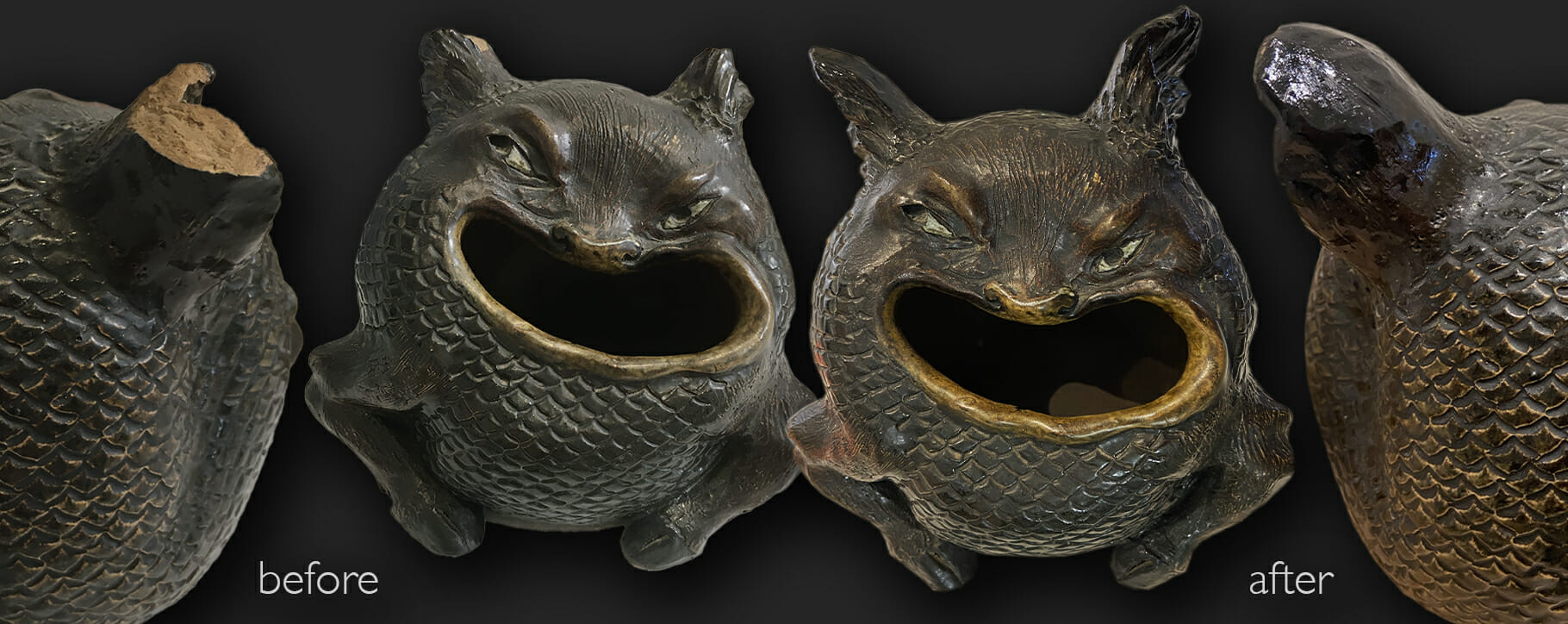 Above: a Martinware spoon warmer which was restored in our studio including the recreation of missing ears
Above: a Martinware spoon warmer which was restored in our studio including the recreation of missing ears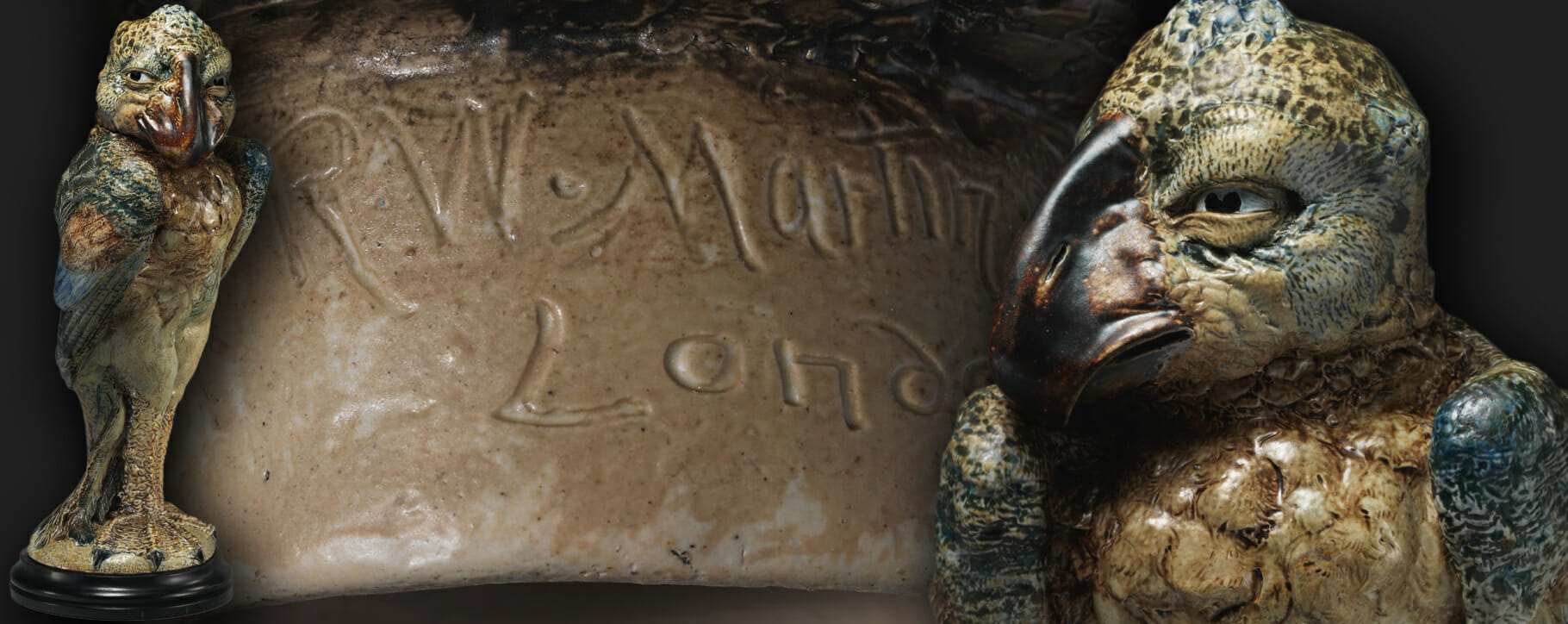 Above: a Martin Brothers tall bird sculpture jar from 1896
Above: a Martin Brothers tall bird sculpture jar from 1896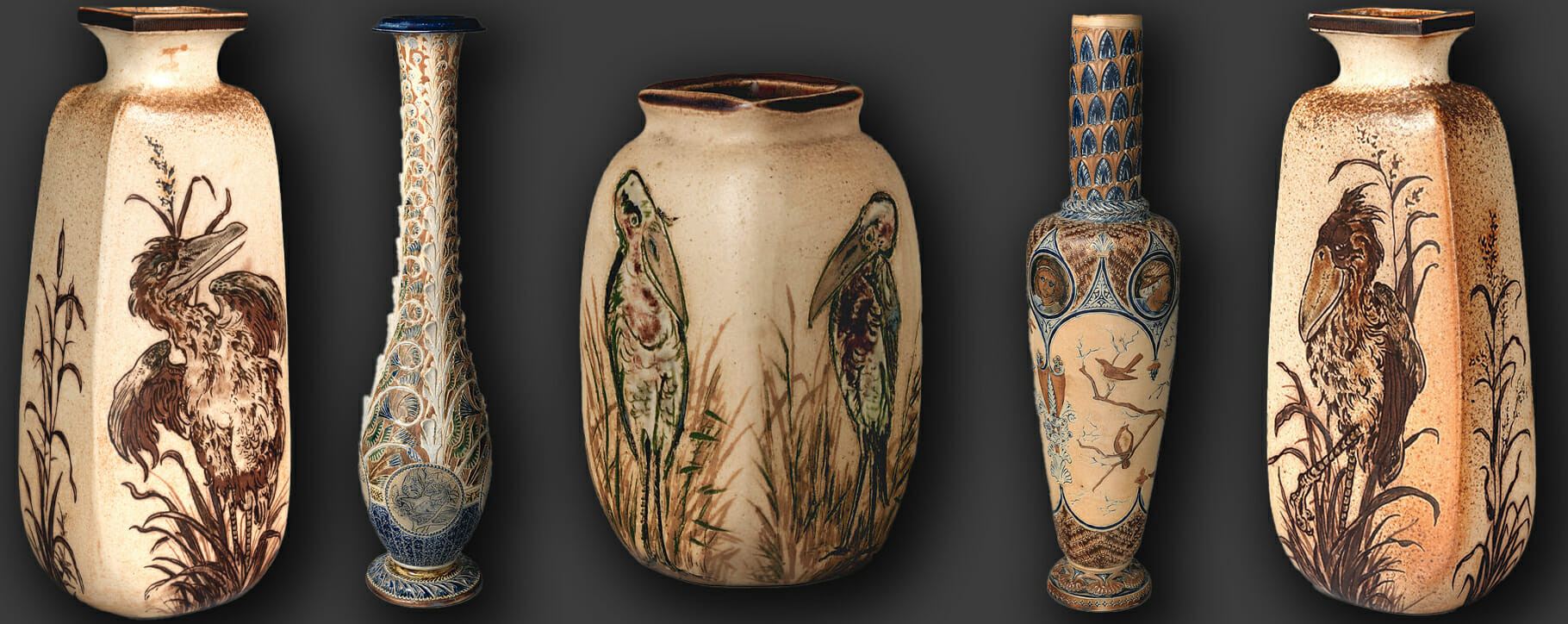 Above: a selection of vases from the Martin Brothers studio, all from various points in their history from the 1870s through to 1900
Above: a selection of vases from the Martin Brothers studio, all from various points in their history from the 1870s through to 1900 Above: a Martin Brothers jar with four bird heads and colourful glazing dated to 1892
Above: a Martin Brothers jar with four bird heads and colourful glazing dated to 1892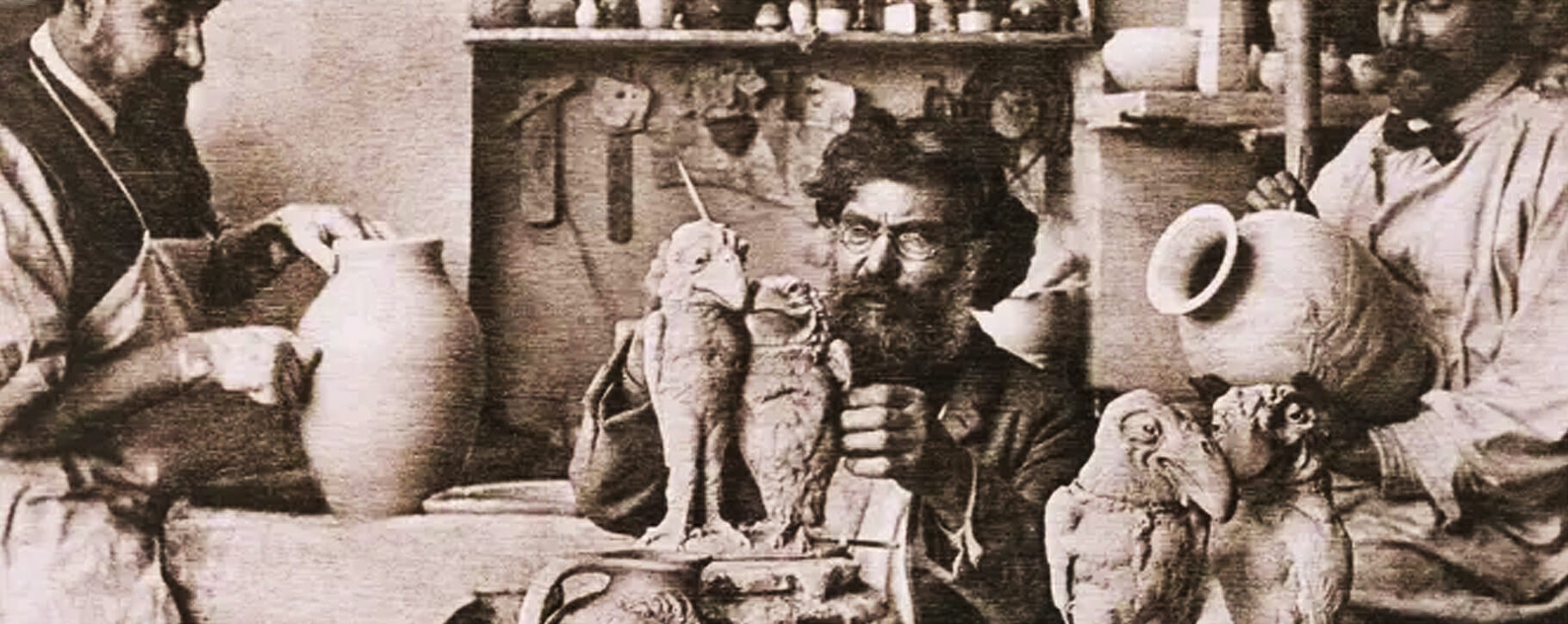 Above: a photograph of the brothers in their pottery studio working on wally bird sculptures
Above: a photograph of the brothers in their pottery studio working on wally bird sculptures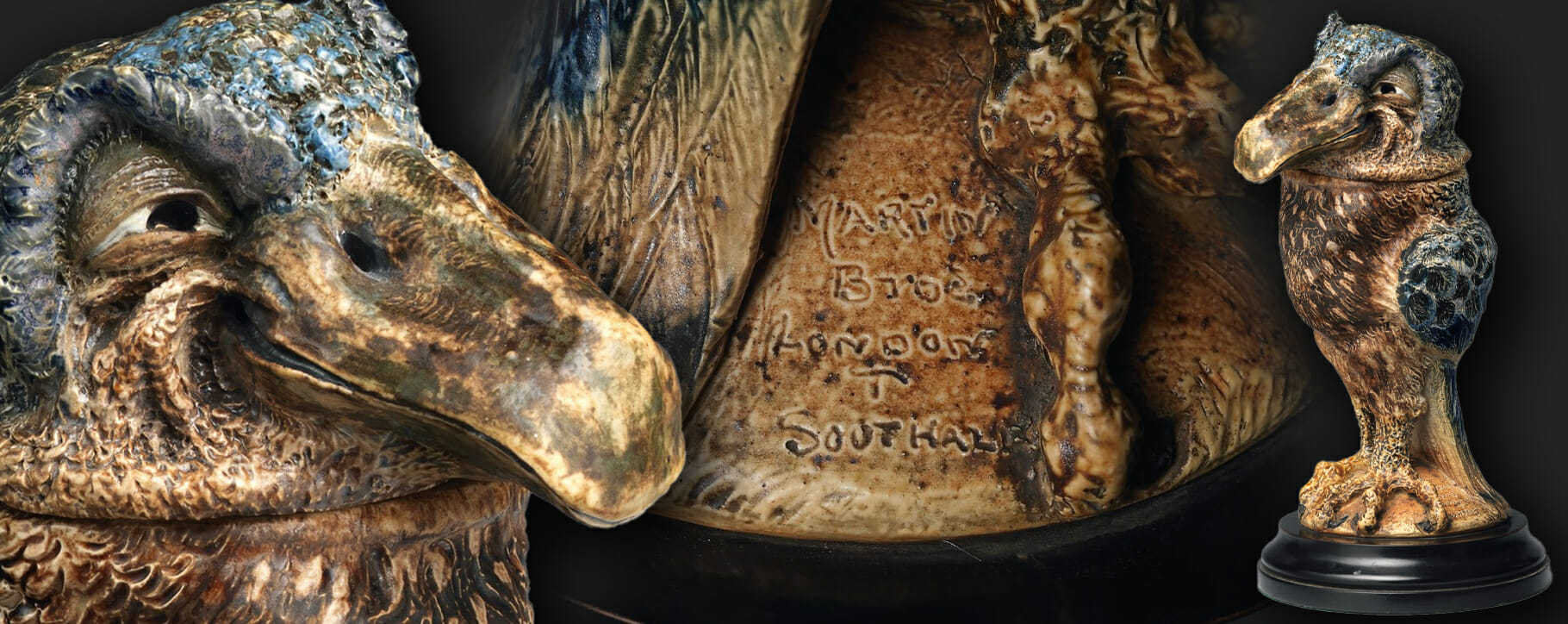 Above: a classic stoneware wally bird jar from 1888 with an inscription from the studio on the base
Above: a classic stoneware wally bird jar from 1888 with an inscription from the studio on the base Above: a Martin Brothers creature jar with a charismatic expression – the inside of the jar head is hand signed and dated to 1885
Above: a Martin Brothers creature jar with a charismatic expression – the inside of the jar head is hand signed and dated to 1885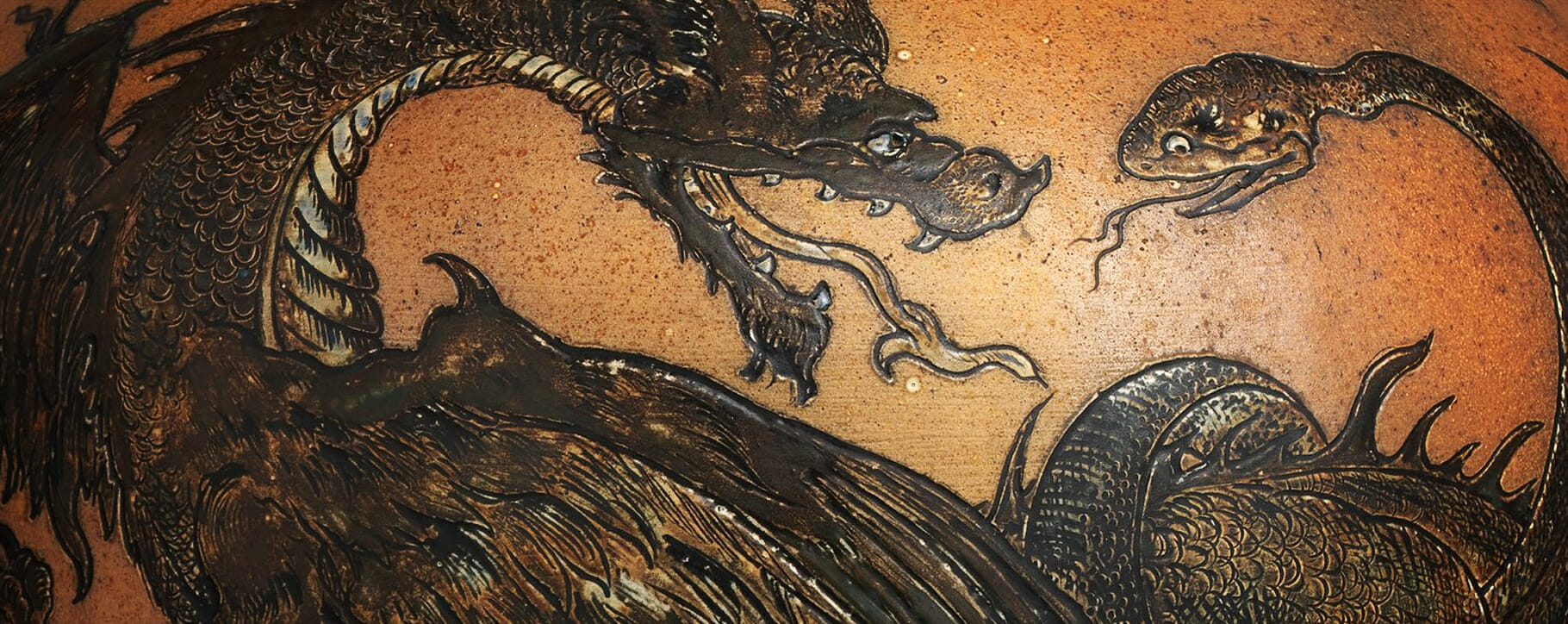 Above: a detail from a Martin Bros vase dated to 1894 showing their Japanese influence from the Exposition Universelle in Paris
Above: a detail from a Martin Bros vase dated to 1894 showing their Japanese influence from the Exposition Universelle in Paris 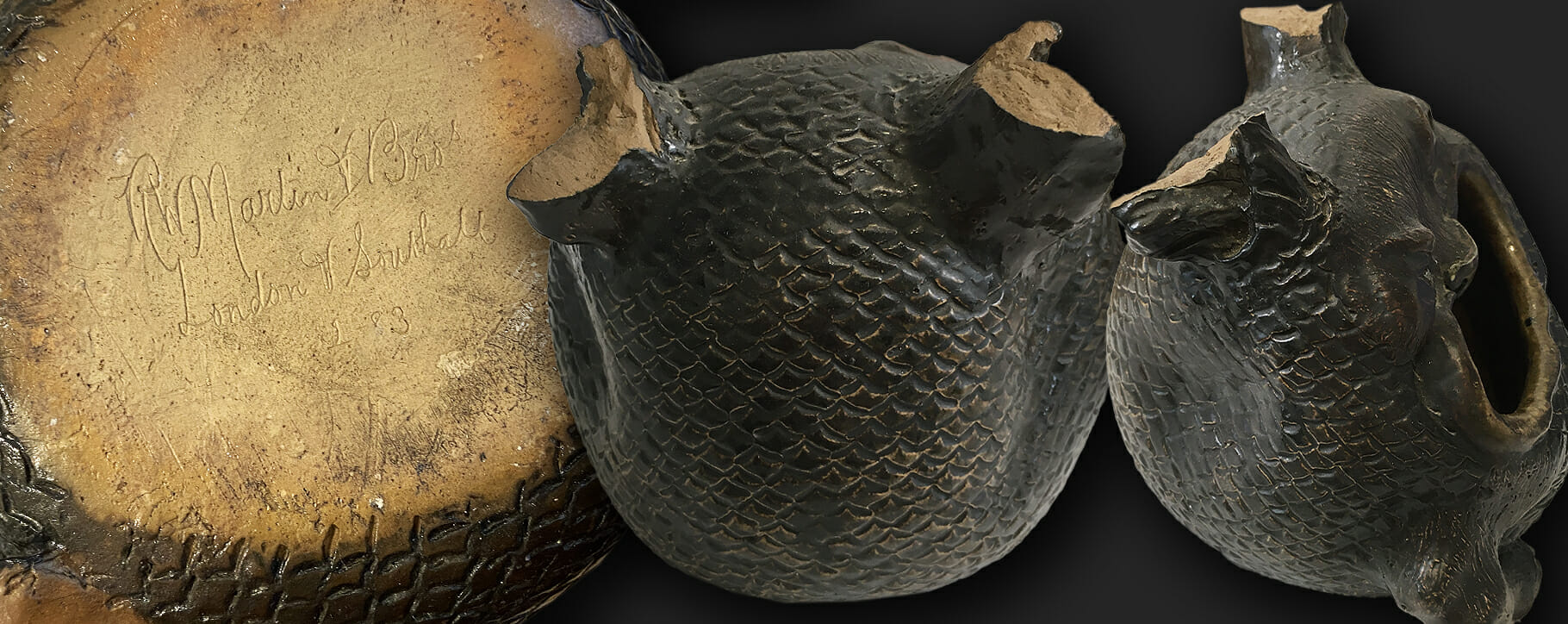 Above: the Martin Brothers spoon warmer before restoration took place showing the base inscription and missing ears
Above: the Martin Brothers spoon warmer before restoration took place showing the base inscription and missing ears Above: the process of our ceramics conservator crafting new ears, taking moulds from the original ends and creating historically and artistically accurate ends
Above: the process of our ceramics conservator crafting new ears, taking moulds from the original ends and creating historically and artistically accurate ends Above: the finished restoration of the Martin Brothers spoon warmer with new ears and a clean surface
Above: the finished restoration of the Martin Brothers spoon warmer with new ears and a clean surface




